Exploration of the Reasons for the Decreases in O3 Concentrations in Tai’an City Based on the Control of O3 Precursor Emissions
Abstract
:1. Introduction
2. Materials and Methods
2.1. Model Configurations and Emission Inventory
2.2. Observational Data
2.3. Description of Simulation Scenarios
3. Results and Discussion
3.1. Analysis of Observational Results
3.2. Model Evaluation
3.3. Impacts of Emission Control and Meteorological Conditions
3.4. Case Studies
4. Conclusions
Supplementary Materials
Author Contributions
Funding
Institutional Review Board Statement
Informed Consent Statement
Data Availability Statement
Conflicts of Interest
References
- Yu, S.; Mathur, R.; Kang, D.; Schere, K.; Eder, B.; Pleim, J. Performance and Diagnostic Evaluation of Ozone Predictions by the Eta-Community Multiscale Air Quality Forecast System during the 2002 New England Air Quality Study. J. Air Waste Manag. Assoc. 2012, 56, 1459–1471. [Google Scholar] [CrossRef] [PubMed]
- Turner, M.C.; Jerrett, M.; Pope, C.A., 3rd; Krewski, D.; Gapstur, S.M.; Diver, W.R.; Beckerman, B.S.; Marshall, J.D.; Su, J.; Crouse, D.L.; et al. Long-Term Ozone Exposure and Mortality in a Large Prospective Study. Am. J. Respir. Crit. Care Med. 2016, 193, 1134–1142. [Google Scholar] [CrossRef]
- Liu, S.; Zhang, Y.; Ma, R.; Liu, X.; Liang, J.; Lin, H.; Shen, P.; Zhang, J.; Lu, P.; Tang, X.; et al. Long-term exposure to ozone and cardiovascular mortality in a large Chinese cohort. Environ. Int. 2022, 165, 107280. [Google Scholar] [CrossRef]
- Ainsworth, E.A.; Yendrek, C.R.; Sitch, S.; Collins, W.J.; Emberson, L.D. The Effects of Tropospheric Ozone on Net Primary Productivity and Implications for Climate Change. Annu. Rev. Plant Biol. 2012, 63, 637–661. [Google Scholar] [CrossRef]
- Mills, G.; Pleijel, H.; Malley, C.; Sinha, B.; Cooper, O.; Schultz, M.; Neufeld, H.; Simpson, D.; Sharps, K.; Feng, Z.; et al. Tropospheric Ozone Assessment Report: Present-day tropospheric ozone distribution and trends relevant to vegetation. Elementa Sci. Anthrop. 2018, 6, 47. [Google Scholar] [CrossRef]
- Xu, T.; Zhang, C.; Liu, C.; Hu, Q. Variability of PM2.5 and O3 concentrations and their driving forces over Chinese megacities during 2018–2020. J. Environ. Sci. 2023, 124, 1–10. [Google Scholar] [CrossRef] [PubMed]
- Wang, T.; Xue, L.; Brimblecombe, P.; Lam, Y.F.; Li, L.; Zhang, L. Ozone pollution in China: A review of concentrations, meteorological influences, chemical precursors, and effects. Sci. Total Environ. 2017, 575, 1582–1596. [Google Scholar] [CrossRef]
- Feng, Y.; Ning, M.; Lei, Y.; Sun, Y.; Liu, W.; Wang, J. Defending blue sky in China: Effectiveness of the “Air Pollution Prevention and Control Action Plan” on air quality improvements from 2013 to 2017. J. Environ. Manag. 2019, 252, 109603. [Google Scholar] [CrossRef]
- MEEPRC. China Ecological Environment Status Bulletin 2022. 2023. Available online: https://www.mee.gov.cn/hjzl/sthjzk/zghjzkgb/202305/P020230529570623593284.pdf (accessed on 23 April 2025).
- Lu, X.; Zhang, S.; Xing, J.; Wang, Y.; Chen, W.; Ding, D.; Wu, Y.; Wang, S.; Duan, L.; Hao, J. Progress of Air Pollution Control in China and Its Challenges and Opportunities in the Ecological Civilization Era. Engineering 2020, 6, 1423–1431. [Google Scholar] [CrossRef]
- Zheng, H.; Kong, S.; He, Y.; Song, C.; Cheng, Y.; Yao, L.; Chen, N.; Zhu, B. Enhanced ozone pollution in the summer of 2022 in China: The roles of meteorology and emission variations. Atmos. Environ. 2023, 301, 119701. [Google Scholar] [CrossRef]
- Li, C.; Li, F.; Cheng, Q.; Guo, Y.; Zhang, Z.; Liu, X.; Qu, Y.; An, J.; Liu, Y.; Zhang, S. Divergent summertime surface O3 pollution formation mechanisms in two typical Chinese cities in the Beijing-Tianjin-Hebei region and Fenwei Plain. Sci. Total Environ. 2023, 870, 161868. [Google Scholar] [CrossRef]
- Liu, C.; He, C.; Wang, Y.; He, G.; Liu, N.; Miao, S.; Wang, H.; Lu, X.; Fan, S. Characteristics and mechanism of a persistent ozone pollution event in Pearl River Delta induced by typhoon and subtropical high. Atmos. Environ. 2023, 310, 119964. [Google Scholar] [CrossRef]
- Lu, X.; Hong, J.; Zhang, L.; Cooper, O.R.; Schultz, M.G.; Xu, X.; Wang, T.; Gao, M.; Zhao, Y.; Zhang, Y. Severe Surface Ozone Pollution in China: A Global Perspective. Environ. Sci. Technol. Lett. 2018, 5, 487–494. [Google Scholar] [CrossRef]
- Xu, Y.; Zhang, W.; Huo, T.; Streets, D.G.; Wang, C. Investigating the spatio-temporal influences of urbanization and other socioeconomic factors on city-level industrial NOx emissions: A case study in China. Environ. Impact Assess. Rev. 2023, 99, 106998. [Google Scholar] [CrossRef]
- Chen, X.; Zhou, M.; Tang, X. Research on the optimal control strategy for pollution reduction in winter under the constraints of urban air quality targets. Chin. J. Manag. Sci. 2023, 31, 1–9. [Google Scholar]
- Liu, Y.; Wang, T. Worsening urban ozone pollution in China from 2013 to 2017—Part 1: The complex and varying roles of meteorology. Atmos. Chem. Phys. 2020, 20, 6305–6321. [Google Scholar] [CrossRef]
- Lu, X.; Zhang, L.; Chen, Y.; Zhou, M.; Zheng, B.; Li, K.; Liu, Y.; Lin, J.; Fu, T.-M.; Zhang, Q. Exploring 2016–2017 surface ozone pollution over China: Source contributions and meteorological influences. Atmos. Chem. Phys. 2019, 19, 8339–8361. [Google Scholar] [CrossRef]
- Ding, J.; Dai, Q.; Fan, W.; Lu, M.; Zhang, Y.; Han, S.; Feng, Y. Impacts of meteorology and precursor emission change on O3 variation in Tianjin, China from 2015 to 2021. J. Environ. Sci. 2023, 126, 506–516. [Google Scholar] [CrossRef]
- Yu, S. Fog geoengineering to abate local ozone pollution at ground level by enhancing air moisture. Environ. Chem. Lett. 2018, 17, 565–580. [Google Scholar] [CrossRef]
- Dang, R.; Liao, H.; Fu, Y. Quantifying the anthropogenic and meteorological influences on summertime surface ozone in China over 2012–2017. Sci. Total Environ. 2021, 754, 142394. [Google Scholar] [CrossRef]
- Wang, Y.; Gao, W.; Wang, S.; Song, T.; Gong, Z.; Ji, D.; Wang, L.; Liu, Z.; Tang, G.; Huo, Y.; et al. Contrasting trends of PM2.5 and surface-ozone concentrations in China from 2013 to 2017. Natl. Sci. Rev. 2020, 7, 1331–1339. [Google Scholar] [CrossRef]
- Zeng, Y.; Cao, Y.; Qiao, X.; Seyler, B.C.; Tang, Y. Air pollution reduction in China: Recent success but great challenge for the future. Sci. Total Environ. 2019, 663, 329–337. [Google Scholar] [CrossRef]
- Xiao, X.; Cohan, D.S.; Byun, D.W.; Ngan, F. Highly nonlinear ozone formation in the Houston region and implications for emission controls. J. Geophys. Res. Atmos. 2010, 115, D23. [Google Scholar] [CrossRef]
- Di, T.; Cohan, D.S.; Napelenok, S.; Bergin, M.; Hu, Y.; Chang, M.; Russell, A.G. Uncertainty Analysis of Ozone Formation and Response to Emission Controls Using Higher-Order Sensitivities. J. Air Waste Manag. Assoc. 2010, 60, 797–804. [Google Scholar]
- Cohan, D.S.; Hakami, A.; Hu, Y.; Russell, A.G. Nonlinear Response of Ozone to Emissions: Source Apportionment and Sensitivity Analysis. Environ. Sci. Technol. 2005, 39, 6739–6748. [Google Scholar] [CrossRef]
- Li, K.; Liu, M.; Mei, R. Pollution Characteristics and Sensitivity Analysis of Atmospheric Ozone in Tai’an City. Environ. Sci. 2020, 41, 3539–3546. [Google Scholar]
- Zhang, C.; Song, Y.; Wang, H.; Zeng, L.; Hu, M.; Lu, K.; Xie, S.; Carter, W.P.L. Observation-Based Estimations of Relative Ozone Impacts by Using Volatile Organic Compounds Reactivities. Environ. Sci. Technol. Lett. 2021, 9, 10–15. [Google Scholar] [CrossRef]
- Feng, R.; Luo, K.; Fan, J.-R. Decoding Tropospheric Ozone in Hangzhou, China: From Precursors to Sources. Asia-Pac. J. Atmos. Sci. 2019, 56, 321–331. [Google Scholar] [CrossRef]
- Wu, Y.; Wang, P.; Yu, S.; Wang, L.; Li, P.; Li, Z.; Mehmood, K.; Liu, W.; Wu, J.; Lichtfouse, E.; et al. Residential emissions predicted as a major source of fine particulate matter in winter over the Yangtze River Delta, China. Environ. Chem. Lett. 2018, 16, 1117–1127. [Google Scholar] [CrossRef]
- Yan, R.; Wang, H.; Huang, C.; An, J.; Bai, H.; Wang, Q.; Gao, Y.; Jing, S.; Wang, Y.; Su, H. Impact of spatial scales of control measures on the effectiveness of ozone pollution mitigation in eastern China. Sci. Total Environ. 2024, 906, 167521. [Google Scholar] [CrossRef] [PubMed]
- Wang, Y.; Liao, H. Effect of emission control measures on ozone concentrations in Hangzhou during G20 meeting in 2016. Chemosphere 2020, 261, 127729. [Google Scholar] [CrossRef]
- Yu, S.; Mathur, R.; Pleim, J.; Wong, D.; Gilliam, R.; Alapaty, K.; Zhao, C.; Liu, X. Aerosol indirect effect on the grid-scale clouds in the two-way coupled WRF–CMAQ: Model description, development, evaluation and regional analysis. Atmos. Chem. Phys. 2014, 14, 11247–11285. [Google Scholar] [CrossRef]
- Pleim, J.E. A Combined Local and Nonlocal Closure Model for the Atmospheric Boundary Layer. Part I: Model Description and Testing. J. Appl. Meteorol. Climatol. 2007, 46, 1383–1395. [Google Scholar] [CrossRef]
- Thompson, G.; Morrison, H.; Tatarskii, V. Impact of Cloud Microphysics on the Development of Trailing Stratiform Precipitation in a Simulated Squall Line: Comparison of One- and Two-Moment Schemes. Mon. Weather Rev. 2009, 137, 991–1007. [Google Scholar]
- Dou, X.; Li, M.; Jiang, Y.; Song, Z.; Li, P.; Yu, S. Different contributions of meteorological conditions and emission reductions to the ozone pollution during Shanghai’s COVID-19 lockdowns in winter and spring. Atmos. Pollut. Res. 2024, 15, 102252. [Google Scholar] [CrossRef]
- Zhang, Y.; Yu, S.; Chen, X.; Li, Z.; Li, M.; Song, Z.; Liu, W.; Li, P.; Zhang, X.; Lichtfouse, E.; et al. Local production, downward and regional transport aggravated surface ozone pollution during the historical orange-alert large-scale ozone episode in eastern China. Environ. Chem. Lett. 2022, 20, 1577–1588. [Google Scholar] [CrossRef]
- Liu, Y.; Wang, T.; Stavrakou, T.; Elguindi, N.; Doumbia, T.; Granier, C.; Bouarar, I.; Gaubert, B.; Brasseur, G.P. Diverse response of surface ozone to COVID-19 lockdown in China. Sci. Total Environ. 2021, 789, 147739. [Google Scholar] [CrossRef]
- Yao, S.; Wei, W.; Cheng, S.; Niu, Y.; Guan, P. Impacts of Meteorology and Emissions on O3 Pollution during 2013–2018 and Corresponding Control Strategy for a Typical Industrial City of China. Atmosphere 2021, 12, 619. [Google Scholar] [CrossRef]
- Zhou, M.; Li, Y.; Zhang, F. Spatiotemporal Variation in Ground Level Ozone and Its Driving Factors: A Comparative Study of Coastal and Inland Cities in Eastern China. Int. J. Environ. Res. Public Health 2022, 19, 9687. [Google Scholar] [CrossRef] [PubMed]
- Liu, P.; Song, H.; Wang, T.; Wang, F.; Li, X.; Miao, C.; Zhao, H. Effects of meteorological conditions and anthropogenic precursors on ground-level ozone concentrations in Chinese cities. Environ. Pollut. 2020, 262, 114366. [Google Scholar] [CrossRef]
- Yang, L.; Luo, H.; Yuan, Z.; Zheng, J.; Huang, Z.; Li, C.; Lin, X.; Louie, P.K.K.; Chen, D.; Bian, Y. Quantitative impacts of meteorology and precursor emission changes on the long-term trend of ambient ozone over the Pearl River Delta, China, and implications for ozone control strategy. Atmos. Chem. Phys. 2019, 19, 12901–12916. [Google Scholar] [CrossRef]
- Yu, S.; Eder, B.; Dennis, R.; Chu, S.H.; Schwartz, S.E. New unbiased symmetric metrics for evaluation of air quality models. Atmos. Sci. Lett. 2006, 7, 26–34. [Google Scholar] [CrossRef]
- Wang, L.; Zhou, X.; Liu, Y.; Liu, H.; Zhang, Y.; Fan, G. Characteristics and Source Apportionment of Atmospheric Volatile Organic Compounds of Tai’an Urban Area in Autumn. Acta Sci. Nat. Univ. Pekin. 2024, 60, 329–340. [Google Scholar]
- Hui, L.; Liu, X.; Tan, Q.; Feng, M.; An, J.; Qu, Y.; Zhang, Y.; Jiang, M. Characteristics, source apportionment and contribution of VOCs to ozone formation in Wuhan, Central China. Atmos. Environ. 2018, 192, 55–71. [Google Scholar] [CrossRef]
- Shandong Provincial Bureau of Statistics. Shandong Statistics Yearbook 2022; China Statistics Press: Beijing, China, 2022. [Google Scholar]
- Sillman, S.; Samson, P.J. Impact of temperature on oxidant photochemistry in urban, polluted rural and remote environments. J. Geophys. Res. Atmos. 1995, 100, 11497–11508. [Google Scholar] [CrossRef]
- Zhao, S.; Yu, Y.; Yin, D.; Qin, D.; He, J.; Dong, L. Spatial patterns and temporal variations of six criteria air pollutants during 2015 to 2017 in the city clusters of Sichuan Basin, China. Sci. Total Environ. 2018, 624, 540–557. [Google Scholar] [CrossRef]
- Pusede, S.E.; Steiner, A.L.; Cohen, R.C. Temperature and Recent Trends in the Chemistry of Continental Surface Ozone. Chem. Rev. 2015, 115, 3898–3918. [Google Scholar] [CrossRef]
- Lu, X.; Zhang, L.; Shen, L. Meteorology and Climate Influences on Tropospheric Ozone: A Review of Natural Sources, Chemistry, and Transport Patterns. Curr. Pollut. Rep. 2019, 5, 238–260. [Google Scholar] [CrossRef]
- Coates, J.; Mar, K.A.; Ojha, N.; Butler, T.M. The influence of temperature on ozone production under varying NOx conditions—A modelling study. Atmos. Chem. Phys. 2016, 16, 11601–11615. [Google Scholar] [CrossRef]
- Kavassalis, S.C.; Murphy, J.G. Understanding ozone-meteorology correlations: A role for dry deposition. Geophys. Res. Lett. 2017, 44, 2922–2931. [Google Scholar] [CrossRef]
- Juran, S.; Karl, T.; Ofori-Amanfo, K.K.; Sigut, L.; Zavadilova, I.; Grace, J.; Urban, O. Drought shifts ozone deposition pathways in spruce forest from stomatal to non-stomatal flux. Environ. Pollut. 2025, 372, 126081. [Google Scholar] [CrossRef] [PubMed]
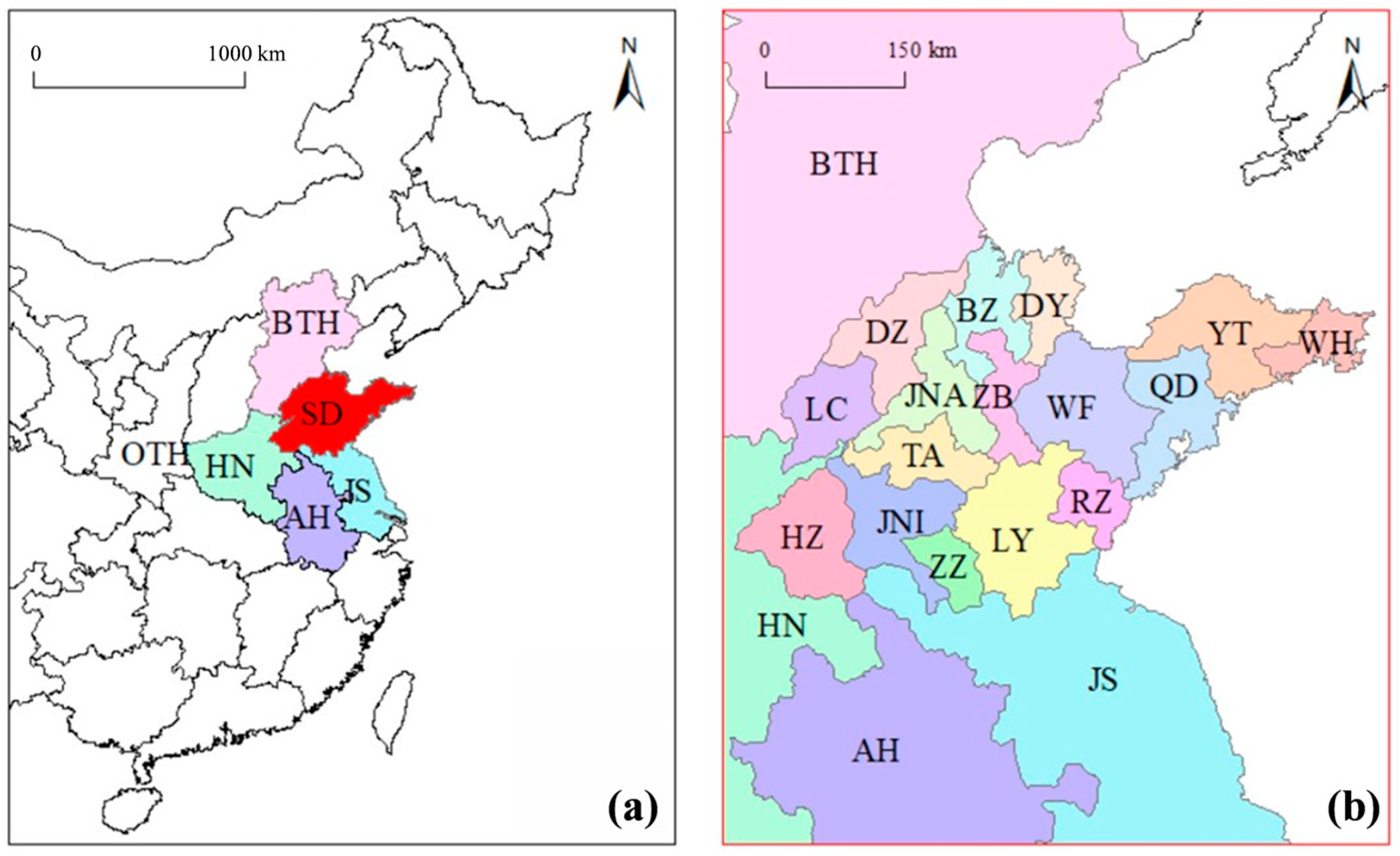
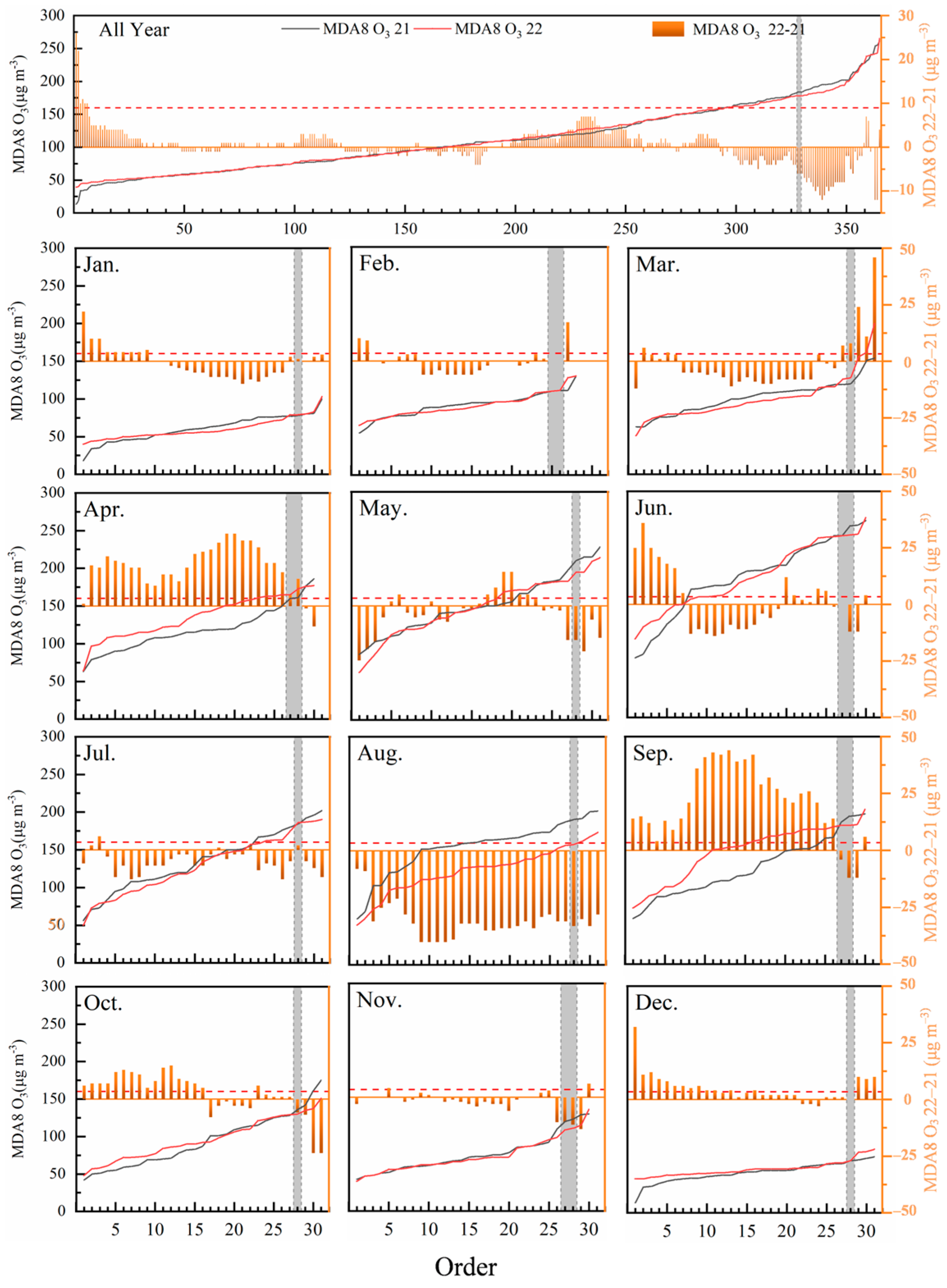
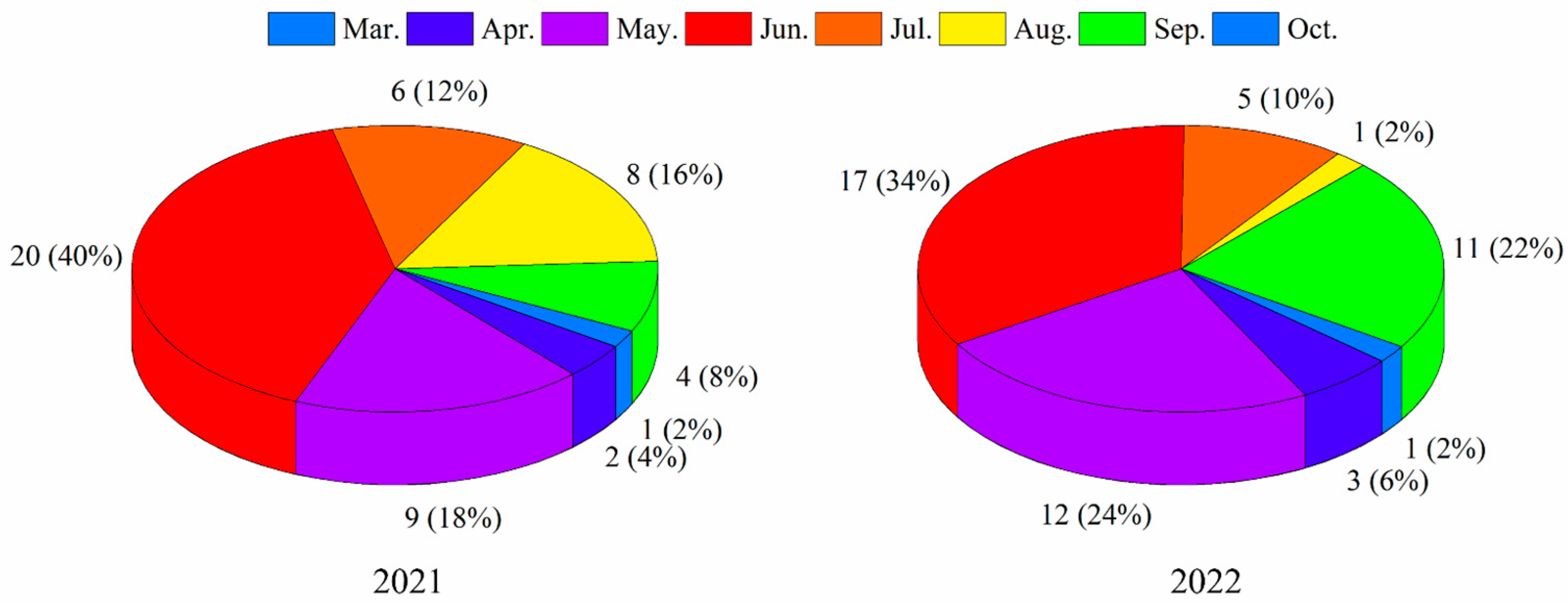
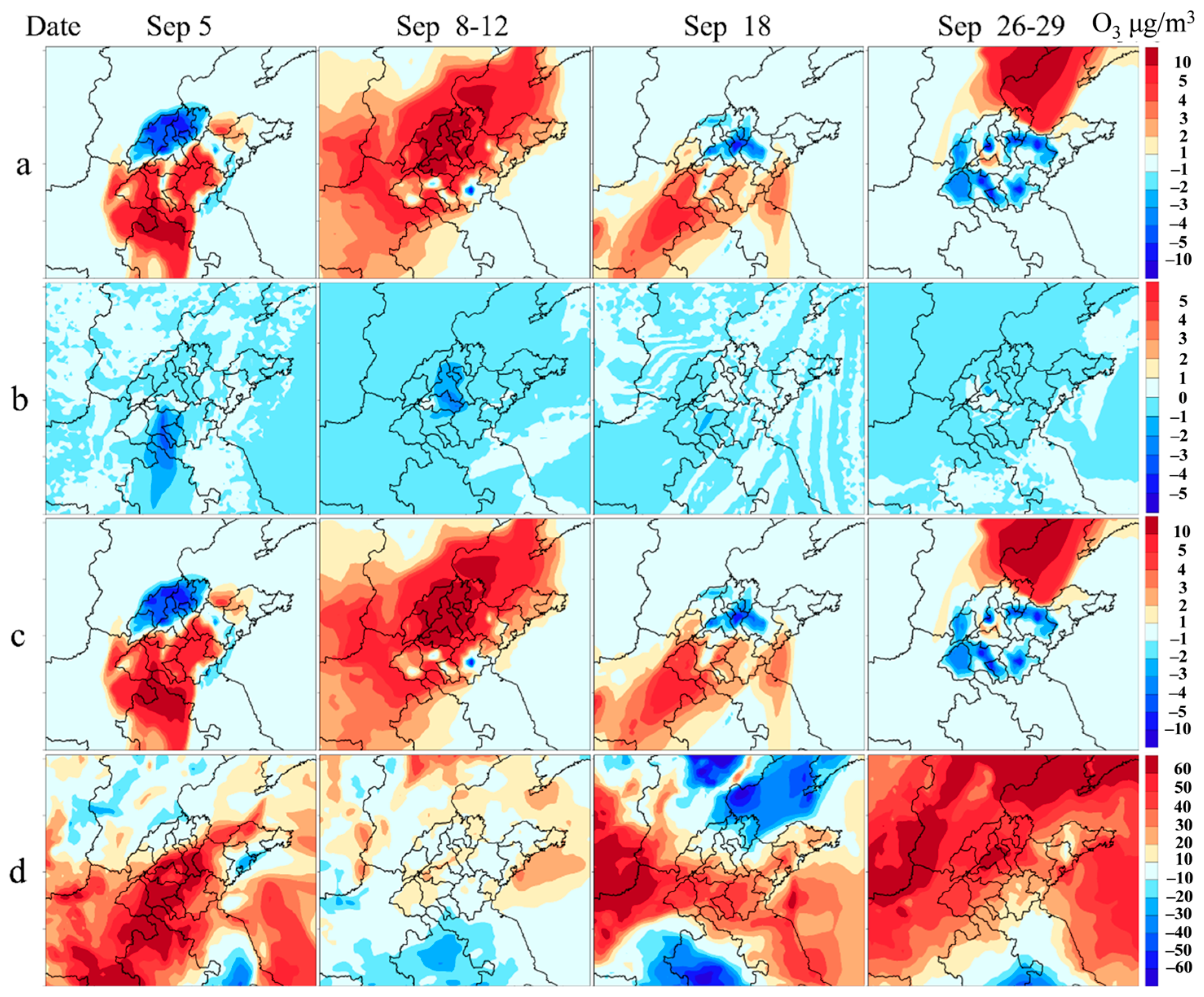
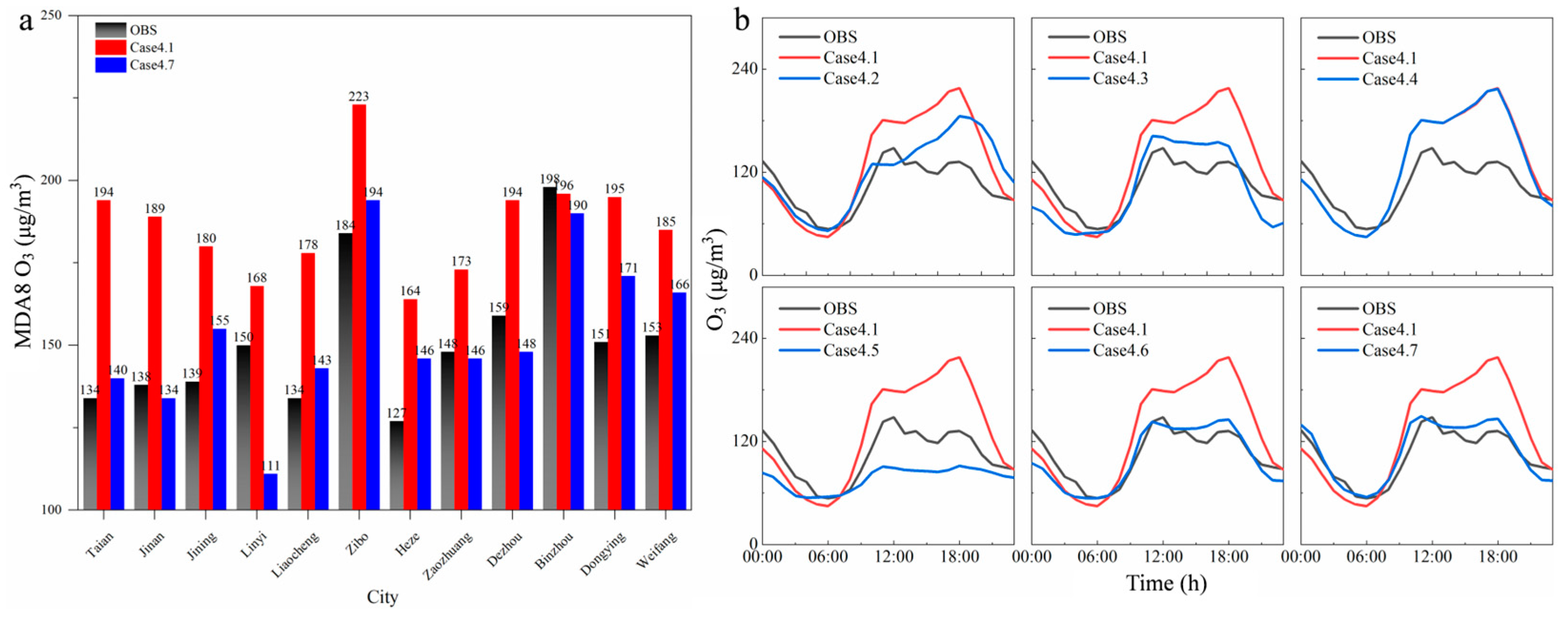

| Cases | Meteorology | Emission Control Areas and Proportions | |||
|---|---|---|---|---|---|
| TA and IN_11 | CO_4, NPC_6 and OTH | ||||
| VOCs | NOx | VOCs | NOx | ||
| Base 1 | SEP_2022 | 100% | 100% | 100% | 100% |
| Base 2 | SEP_2021 | 100% | 100% | 100% | 100% |
| Case 1.1 | HMS_2022 | 100% | 150% | 100% | 100% |
| Case 1.2 | 100% | 125% | 100% | 100% | |
| Case 1.3 | 100% | 110% | 100% | 100% | |
| Case 1.4 | 100% | 90% | 100% | 100% | |
| Case 1.5 | 100% | 75% | 100% | 100% | |
| Case 1.6 | 100% | 50% | 100% | 100% | |
| Case 1.7 | 150% | 100% | 100% | 100% | |
| Case 1.8 | 125% | 100% | 100% | 100% | |
| Case 1.9 | 110% | 100% | 100% | 100% | |
| Case 1.10 | 90% | 100% | 100% | 100% | |
| Case 1.11 | 75% | 100% | 100% | 100% | |
| Case 1.12 | 50% | 100% | 100% | 100% | |
| Case 2.1 | HMS_2021 | 100% | 150% | 100% | 100% |
| Case 2.2 | 100% | 125% | 100% | 100% | |
| Case 2.3 | 100% | 110% | 100% | 100% | |
| Case 2.4 | 100% | 90% | 100% | 100% | |
| Case 2.5 | 100% | 75% | 100% | 100% | |
| Case 2.6 | 100% | 50% | 100% | 100% | |
| Case 2.7 | 150% | 100% | 100% | 100% | |
| Case 2.8 | 125% | 100% | 100% | 100% | |
| Case 2.9 | 110% | 100% | 100% | 100% | |
| Case 2.10 | 90% | 100% | 100% | 100% | |
| Case 2.11 | 75% | 100% | 100% | 100% | |
| Case 2.12 | 50% | 100% | 100% | 100% | |
| Cases | Meteorology | Emission Control Areas and Proportions | |||||
|---|---|---|---|---|---|---|---|
| TA | IN_11 | CO_4, NPC_6 and OTH | |||||
| VOCs | NOx | VOCs | NOx | VOCs | NOx | ||
| Case 3.1 | HMS_2022 | 100% | 100% | 150% | 100% | 100% | 100% |
| Case 3.2 | 75% | 75% | 150% | 100% | 100% | 100% | |
| Case 3.3 | 50% | 50% | 150% | 100% | 100% | 100% | |
| Case 3.4 | 25% | 25% | 150% | 100% | 100% | 100% | |
| Case 3.5 | 0 | 0 | 150% | 100% | 100% | 100% | |
| Case 3.6 | 25% | 25% | 100% | 50% | 100% | 100% | |
| Case 3.7 | 100% | 50% | 150% | 100% | 100% | 100% | |
| Case 3.8 | 100% | 50% | 100% | 50% | 100% | 100% | |
| Case 3.9 | HMS_2021 | 25% | 25% | 150% | 100% | 100% | 100% |
| Cases | Meteorology | Emission Control Areas and Proportions | |||||
|---|---|---|---|---|---|---|---|
| TA | IN_11 and CO_4 | NPC_6 | |||||
| VOCs | NOx | VOCs | NOx | VOCs | NOx | ||
| Case 4.1 | 1~2 August 2022 | 100% | 100% | 100% | 100% | 100% | 100% |
| Case 4.2 | 0 | 0 | 100% | 100% | 100% | 100% | |
| Case 4.3 | 100% | 100% | 0 | 0 | 100% | 100% | |
| Case 4.4 | 100% | 100% | 100% | 100% | 0 | 0 | |
| Case 4.5 | 0 | 0 | 0 | 0 | 100% | 100% | |
| Case 4.6 | 50% | 50% | 10% | 10% | 100% | 100% | |
| Case 4.7 | 50% | 50% | * | * | 100% | 100% | |
| Cases | Type | O3–8h-90per | Ave_MDA8 O3 (The Highest 50) | ||||||
|---|---|---|---|---|---|---|---|---|---|
| Year | Year | ||||||||
| 2021 | 2022 | Change Rate | Ranking | 2021 | 2022 | Change Rate | Ranking | ||
| Tai’an | TA | 184.0 | 178.0 | −3.3% | 1 | 200.4 | 195.0 | −2.7% | 2 |
| Rizhao | CO_4 | 153.6 | 151.0 | −1.7% | 2 | 170.5 | 164.2 | −3.7% | 1 |
| Jinan | IN_11 | 180.6 | 182.0 | 0.8% | 3 | 197.4 | 199.3 | 1.0% | 3 |
| Binzhou | IN_11 | 180.0 | 184.6 | 2.6% | 4 | 196.3 | 206.0 | 4.9% | 8 |
| Yantai | CO_4 | 150.0 | 156.6 | 4.4% | 5 | 160.1 | 173.0 | 8.0% | 13 |
| Heze | IN_11 | 168.6 | 176.2 | 4.5% | 6 | 189.3 | 195.4 | 3.3% | 6 |
| Linyi | IN_11 | 168.0 | 176.0 | 4.8% | 7 | 185.5 | 191.4 | 3.2% | 5 |
| Zaozhuang | IN_11 | 172.6 | 181.6 | 5.2% | 8 | 190.6 | 195.3 | 2.5% | 4 |
| Zibo | IN_11 | 182.0 | 191.6 | 5.3% | 9 | 198.0 | 208.1 | 5.1% | 10 |
| Liaocheng | IN_11 | 166.2 | 176.8 | 6.4% | 10 | 185.4 | 196.1 | 5.8% | 11 |
| Qingdao | CO_4 | 143.6 | 153.6 | 7.0% | 11 | 160.5 | 168.4 | 4.9% | 9 |
| Weihai | CO_4 | 145.0 | 155.6 | 7.3% | 12 | 156.8 | 170.6 | 8.8% | 14 |
| Jining | IN_11 | 169.2 | 182.0 | 7.6% | 13 | 189.0 | 200.8 | 6.2% | 12 |
| Dezhou | IN_11 | 170.6 | 183.6 | 7.6% | 14 | 191.0 | 199.5 | 4.4% | 7 |
| Weifang | IN_11 | 155.0 | 168.0 | 8.4% | 15 | 165.8 | 186.0 | 12.2% | 16 |
| Dongying | IN_11 | 166.0 | 185.2 | 11.6% | 16 | 182.3 | 201.6 | 10.6% | 15 |
Disclaimer/Publisher’s Note: The statements, opinions and data contained in all publications are solely those of the individual author(s) and contributor(s) and not of MDPI and/or the editor(s). MDPI and/or the editor(s) disclaim responsibility for any injury to people or property resulting from any ideas, methods, instructions or products referred to in the content. |
© 2025 by the authors. Licensee MDPI, Basel, Switzerland. This article is an open access article distributed under the terms and conditions of the Creative Commons Attribution (CC BY) license (https://creativecommons.org/licenses/by/4.0/).
Share and Cite
Liu, Y.; Yu, S.; Shi, Q.; Song, Z.; Yao, N.; Xi, H.; Chen, L.; Ge, Y.; Yang, T.; Wang, Y.; et al. Exploration of the Reasons for the Decreases in O3 Concentrations in Tai’an City Based on the Control of O3 Precursor Emissions. Atmosphere 2025, 16, 505. https://doi.org/10.3390/atmos16050505
Liu Y, Yu S, Shi Q, Song Z, Yao N, Xi H, Chen L, Ge Y, Yang T, Wang Y, et al. Exploration of the Reasons for the Decreases in O3 Concentrations in Tai’an City Based on the Control of O3 Precursor Emissions. Atmosphere. 2025; 16(5):505. https://doi.org/10.3390/atmos16050505
Chicago/Turabian StyleLiu, Yanfei, Shaocai Yu, Qiao Shi, Zhe Song, Ningning Yao, Huan Xi, Lang Chen, Yanzhen Ge, Tongsuo Yang, Yan Wang, and et al. 2025. "Exploration of the Reasons for the Decreases in O3 Concentrations in Tai’an City Based on the Control of O3 Precursor Emissions" Atmosphere 16, no. 5: 505. https://doi.org/10.3390/atmos16050505
APA StyleLiu, Y., Yu, S., Shi, Q., Song, Z., Yao, N., Xi, H., Chen, L., Ge, Y., Yang, T., Wang, Y., Chen, J., & Li, P. (2025). Exploration of the Reasons for the Decreases in O3 Concentrations in Tai’an City Based on the Control of O3 Precursor Emissions. Atmosphere, 16(5), 505. https://doi.org/10.3390/atmos16050505










